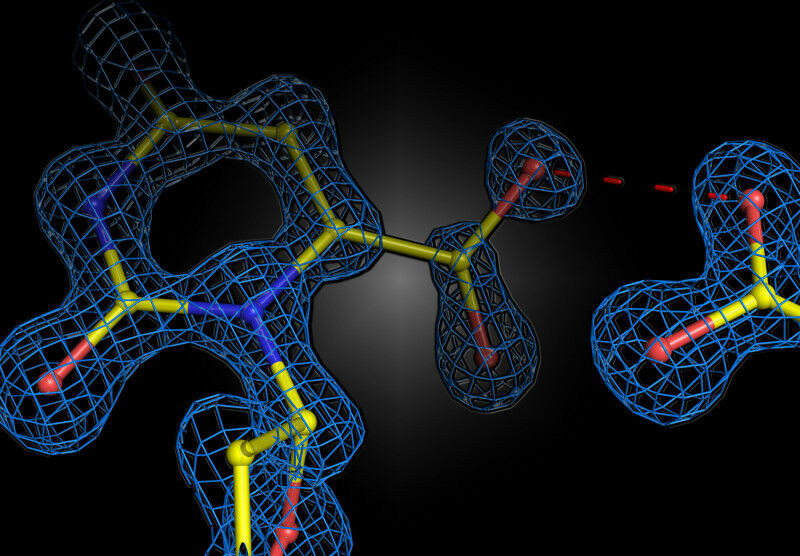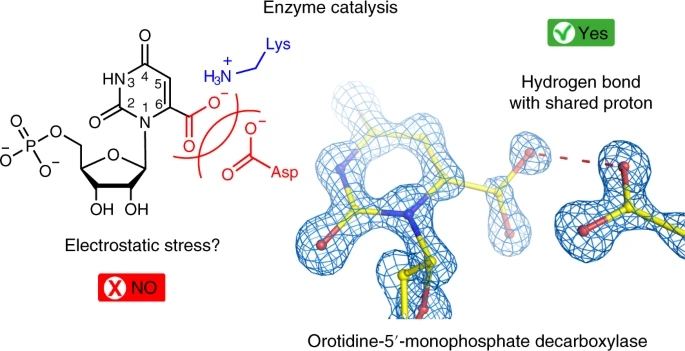博文
酶中的等电荷如何控制生化反应
||
酶中的等电荷如何控制生化反应
诸平


Fig.2 Professor Kai Tittmann

Fig.3 Professor Ricardo Mata
https://www.uni-goettingen.de/en/3240.html?id=6657
据德国哥廷根大学(University of Göttingen)2022年4月22日报道,酶中的等电荷如何控制生化反应(How equal charges in enzymes control biochemical reactions)。哥廷根大学领导的研究小组描述了酶催化的基本原理。在物理学和化学中众所周知,相等的电荷相互排斥,而相反的电荷相互吸引。长期以来,人们一直认为,当酶——所有生物体中的生物催化剂——形成或破坏化学键时,这一原理也适用。人们认为,酶将电荷放置在它们的“活性中心”,化学反应实际上发生的地方,以这样一种方式,它们排斥来自它们周围的其他分子的类似电荷。这个概念被称为“静电应力(electrostatic stress)”。例如,如果底物(酶作用的物质)带有负电荷,酶可以使用负电荷来“强调(stress)”底物,从而促进反应。然而,哥廷根大学和哥廷根马克斯普朗克多学科科学研究所(Max Planck Institute for Multidisciplinary Sciences in Göttingen)的一项新研究表明,与预期相反,两个相等的电荷并不一定会导致排斥,但会在酶中引起吸引。相关研究结果于2022年4月21日已经在《自然催化》(Nature Catalysis)杂志网站发表——Sören Rindfleisch, Matthias Krull, Jon Uranga, Tobias Schmidt, Fabian Rabe von Pappenheim, Laura Liliana Kirck, Angeliki Balouri, Thomas Schneider, Ashwin Chari, Ronald Kluger, Gleb Bourenkov, Ulf Diederichsen, Ricardo A. Mata, Kai Tittmann. Ground-state destabilization by electrostatic repulsion is not a driving force in orotidine-5′-monophosphate decarboxylase catalysis. Nature Catalysis, Published: 21 April 2022, 5: 332–341. https://doi.org/10.1038/s41929-022-00771-w
上图是人类酶乳清苷5'-磷酸脱羧酶(orotidine 5’-phosphate decarboxylase)中酶反应的结构快照。底物和酶的两个负电荷不相互排斥,而是形成吸引相互作用。
该团队研究了一种众所周知的酶,该酶已被广泛研究,是酶催化的教科书示例。如果没有这种酶,反应会非常缓慢:事实上,一半的底物需要 7800 万年才能发生反应。酶将该反应加速 10 17次,只需将负电荷和正电荷定位在活动中心即可。由于底物含有一个带负电荷的基团,该基团会以二氧化碳的形式分离出来,因此几十年来人们一直认为酶的负电荷有助于对同样带负电荷的底物施加压力,并加速反应。然而,这种假设的机制仍未得到证实,因为反应的结构太快而无法观察到。
哥廷根大学分子生物科学中心 (Göttingen Center for Molecular Biosciences简称GZMB) 的 卡伊·蒂特曼(Kai Tittmann, Fig. 2)教授小组,现在首次成功地使用蛋白质晶体学在化学反应前不久获得了底物的结构快照。出乎意料的是,酶和底物的负电荷并没有相互排斥。相反,它们共享一个质子,它在有吸引力的相互作用中就像一种分子胶水。“在酶催化的背景下,两个相等的电荷是朋友还是敌人的问题,在我们的领域长期以来一直存在争议,我们的研究表明,酶如何工作的基本原理距离被理解还有很长的路要走,”卡伊·蒂特曼说。哥廷根大学物理化学研究所(Göttingen University’s Institute of Physical Chemistry)的量子化学家里卡多·马塔(Ricardo Mata, Fig. 3)教授和他的团队分析了晶体结构。“两个负电荷之间的额外质子带有正电荷,不仅用于吸引参与反应的分子,而且会引发一系列质子转移反应,进一步加速反应,”里卡多·马塔解释说。
卡伊·蒂特曼说:“我们相信,这些新描述的酶催化原理将有助于开发新的化学催化剂。由于我们研究的酶会释放二氧化碳,这是人类活动产生的最重要的温室气体,我们的研究结果可能有助于发展固定二氧化碳的新化学策略。”
该研究涉及哥廷根分子生物科学中心 (GZMB)、哥廷根大学生物和心理学学院、化学学院以及马克斯·普朗克多学科科学研究所、德国汉堡的欧洲分子生物学实验室 (European Molecular Biology Laboratory简称EMBL, Hamburg, Germany)、加拿大多伦多大学(University of Toronto)的科学家。此论文旨在纪念去年去世的合著者乌尔夫·迪德里希森教授(Professor Ulf Diederichsen)。
上述介绍,仅供参考。欲了解更多信息,敬请注意浏览原文或者相关报道。
The origins of enzyme catalysis have been attributed to both transition-state stabilization as well as ground-state destabilization of the substrate. For the latter paradigm, the enzyme orotidine-5′-monophosphate decarboxylase (OMPDC) serves as a reference system as it contains a negatively charged residue at the active site that is thought to facilitate catalysis by exerting an electrostatic stress on the substrate carboxylate leaving group. Snapshots of how the substrate binds to the active site and interacts with the negative charge have remained elusive. Here we present crystallographic snapshots of human OMPDC in complex with the substrate, substrate analogues, transition-state analogues and product that defy the proposed ground-state destabilization by revealing that the substrate carboxylate is protonated and forms a favourable low-barrier hydrogen bond with a negatively charged residue. The catalytic prowess of OMPDC almost entirely results from the transition-state stabilization by electrostatic interactions of the enzyme with charges spread over the substrate. Our findings bear relevance for the design of (de)carboxylase catalysts.

https://wap.sciencenet.cn/blog-212210-1335461.html
上一篇:科学家们把氢分子变成了量子传感器
下一篇:铁代铂——发明更廉价的氢燃料电池催化剂,会使更好的绿色能源选择